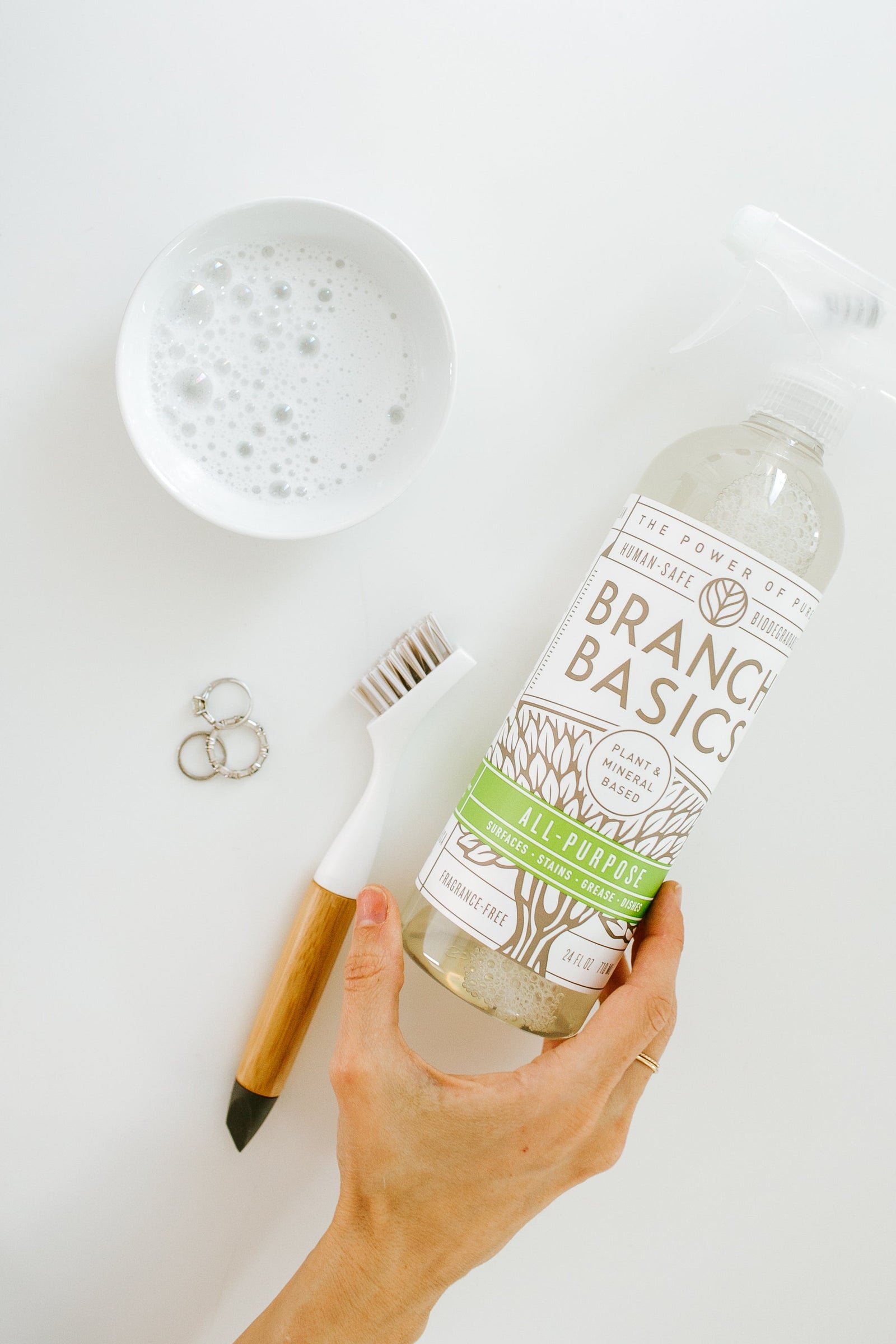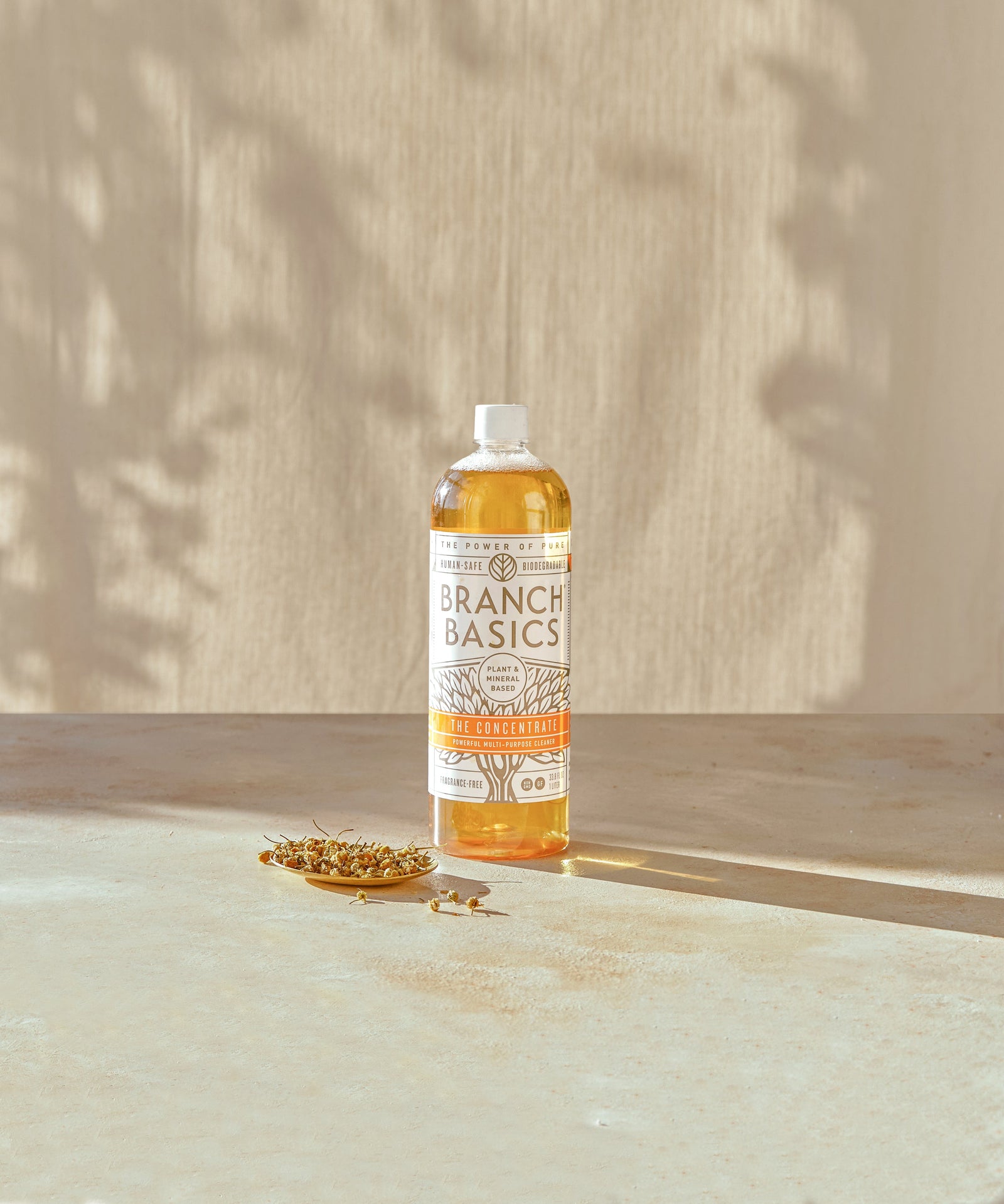How To Clean Jewelry With Branch Basics

Is your favorite heirloom necklace looking a bit dull and tarnished? Or maybe you wore a ring while digging in the garden and dirt is trapped in its tiny crevices. Take a pass on the toxic jewelry cleaners and let us show you how to clean jewelry naturally at home.
Speaking of - conventional jewelry cleaners found at the store are often made with harmful, toxic chemicals, including triclosan (a known carcinogen), alcohol, ammonia, and detergent. These synthetic chemicals are damaging to your health and may cause irreparable damage to precious stones and metals.
Our goal is to provide you with simple, homemade and natural alternatives for cleaning your jewelry.
Here, we’ll include methods made from common household items such as vinegar, baking soda, and salt. We’ll also show you how to use Branch Basic as a mild dish soap ingredient.
Table of Contents:
- How We Approach Cleaning Different Metals
- How to Clean Jewelry With Baking Soda
- How to Clean Jewelry With Vinegar
- How to Clean Jewelry With Dish Soap
- Jewelry Cleaning FAQ
How We Approach Cleaning Different Metals
Cleaning different metal types requires different methods to ensure a positive outcome. Softer metals, like pure gold, should not be cleaned with highly acidic and abrasive ingredients, while harder metals, like silver, can withstand a tougher cleaning solution.
With that in mind, let’s take a look at how we approach cleaning different metals.
Gold Metals
Gold is a softer metal requiring a more gentle cleaning. A natural, mild dish soap, like Branch Basics, and warm water should almost always get the job done.
If necessary, gently scrub with a soft-bristled baby toothbrush. But in most cases, gold should not be scrubbed to protect it from scratching.
Rinse in lukewarm to warm water. Water temperature is important while cleaning gold jewelry. Clean and rinse in similar water temperatures (warm is best!), especially if the jewelry piece is made with a precious stone. Gemstones are prone to cracking when water temperatures drastically change.
Note: Avoid boiling and hot water as it can cause multiple gold jewelry pieces to stick together.
Lastly, use caution with acidic and abrasive solutions including vinegar, baking soda, and salt. Because gold is soft (especially pure gold), it can be easily damaged and scratched.
Sterling Silver, Copper, and Brass Metals
Sterling silver, copper, and brass are harder metals that can (usually) withstand natural jewelry cleaners made from vinegar and baking soda.
But our favorite approach? Branch Basics and warm water. In our opinion, it’s the best natural jewelry cleaner out there.
The kicker, however, is that these metals can tarnish.
Because of this, do not soak silver, copper, or brass pieces for a long time. Soak in warm water for 3 to 5 minutes, use your natural cleaning solution of choice, and give it a gentle scrub. Easy enough!
Also, fully rinse and dry each jewelry piece before storing it. This will help reduce the chance of tarnishing and corrosion happening over time.
How to Clean Jewelry With Baking Soda
Both gentle and effective, baking soda is one of the best natural jewelry cleaners. Because of its slightly abrasive nature, we recommend using baking soda on silver and metallic jewelry. But, it can also be used on some gold.*
Read on for two options on how to clean jewelry with baking soda.
*Note: Do not use baking soda on pure gold pieces (for example, 24 karat gold) and soft, precious stones like opals and pearls.
Option 1: Make a Baking Soda Cleaning Paste
Baking soda cleaning pastes are great for lifting and removing tarnish spots from bracelets, rings, earrings, and necklaces. Mix and gently scrub to reveal like-new jewelry pieces.
What you’ll need:
- 1 tablespoon baking soda
- 1 tablespoon warm water
- Soft-bristled baby toothbrush
- Small bowl
- Microfiber cloth
How To:
-
Step 1: In the small bowl, mix baking soda and warm water to make a paste.
-
Step 2: Dip a clean, soft-bristled baby toothbrush into the paste. Gently apply and scrub jewelry, focusing on tarnish, dirt, and grime.
- Step 3: Rinse in warm water and dry with a microfiber cloth.
Related Read: Cleaning With Baking Soda (Sodium Bicarbonate): 12 Surprising Uses
Option 2: Use Baking Soda and Salt
A baking soda and salt mixture is best used on harder metals like sterling silver, copper, and brass. Adding the salt gives the cleaning solution a boost, especially for tarnished and very dirty jewelry pieces.
What you’ll need:
- 1 tablespoon baking soda
- 1 tablespoon salt
- All-Purpose OR Foaming Wash
- Hot water
- Aluminum foil
- Bowl
- Microfiber cloth
How To:
-
Step 1: Line the bottom of the bowl with aluminum foil. Pour hot water into the bowl, adding the salt, baking soda, and a few sprays of All-Purpose or Foaming Wash. Let sit until the water cools to a warm temperature.
-
Step 2: Gently lower jewelry pieces onto the foil. Let soak for up to 10 minutes. Do not scrub.
- Step 3: Rinse jewelry in warm water and dry well with a microfiber cloth.
How to Clean Jewelry With Vinegar
White vinegar is often recognized as a versatile cleaning ingredient for many homemade DIY options. The same holds true for jewelry. Give vinegar a try when you’re cleaning harder metals like sterling silver, brass, and copper.*
Here we share two options for how to clean jewelry at home with vinegar.
*Note: We do not recommend using vinegar to clean gold, plated jewelry, soft gemstones, and pearls.
Option 1: Use Baking Soda and Vinegar Together
Mix vinegar with a few tablespoons of baking soda to create a powerful and natural jewelry cleaning solution. The chemical reaction between the two ingredients cuts through dirt and grime, leaving your jewelry sparkling (that’s right, no scrubbing necessary!).
What you’ll need:
- 1 cup white distilled vinegar
- 2 tablespoons baking soda
- Small bowl
- Microfiber cloth
How To:
-
Step 1: Place jewelry in the small bowl. Pour the white distilled vinegar over the jewelry until fully covered.
-
Step 2: Add baking soda, allowing to fizz and bubble. Let sit for up to 3 hours.
- Step 3: Rinse the jewelry in clean, lukewarm water. Dry with a microfiber cloth.
Related Read: 12 Ways To Use Vinegar In Your Home
Option 2: Do a Vinegar Soak
Restore sterling silver, copper, and brass jewelry back to its beautiful shine with a quick vinegar soak. The vinegar’s acidity naturally breaks down and removes dirt and grime.
What you’ll need:
- 1 cup white distilled vinegar
- Small bowl
- Soft-bristled toothbrush
- Microfiber cloth
How To:
-
Step 1: Put jewelry pieces in the small bowl. Pour the white distilled vinegar into the bowl until the jewelry is fully covered.
-
Step 2: Let sit for about 15 minutes. Occasionally, lightly swish the jewelry around to help loosen dirt and grime.
-
Step 3: Remove jewelry from the vinegar and gently scrub with a soft-bristled toothbrush, focusing on any tarnished and dirty areas.
- Step 4: Rinse in lukewarm water and dry with a microfiber cloth.
How to Clean Jewelry With Dish Soap
Gentle, human-safe dish soap is safe and effective for cleaning soft and hard metals, and most gemstones. To clean jewelry, we like to use Branch Basics as the mild dish soap ingredient in the following options.
Option 1: Dish Soap and Water Rinse
With the exception of a few stones*, a gentle dish soap and warm water rinse is the safest way to clean jewelry naturally.
What you’ll need:
- All-Purpose OR Foaming Wash
- Small bowl
- Warm water
- Microfiber cloth
How To:
-
Step 1: Put jewelry in a bowl of warm water. Add a few sprays of All-Purpose, or Foaming Wash, and let soak for 3 to 5 minutes or overnight.
-
Step 2: Use a soft brush (we recommend a baby toothbrush), if necessary.
- Step 3: Rinse in water and dry with a clean microfiber cloth.
*Note: Not recommended for opals and pearls.
For more ways to clean with Branch Basics around the house, check out Healthy Cleaning Hacks: 21 Unique Ways to Use Branch Basics
Option 2: Dish Soap and Baking Soda Soak
Mild dish soap paired with baking soda and water work to eliminate dirt and grime from precious metals and stones. Almost magically, a few minutes of soaking does the trick - no scrubbing is necessary.
What you’ll need:
- All-Purpose OR Foaming Wash
- 1 to 3 tablespoons baking soda
- Aluminum Foil
- Small bowl
- Warm water
- Microfiber cloth
How To:
-
Step 1: Line a bowl with a layer of aluminum foil.
-
Step 2: Add baking soda and a few sprays of All-Purpose (or Foaming Wash) to a small bowl of warm water. Allow the solution to fizz before adding the jewelry.
-
Step 3: Gently lower your jewelry pieces into the solution. Soak up to 10 minutes (only 3 to 5 minutes for gold).
-
Step 4: Carefully remove the jewelry from the bowl and rinse in clean water (do not scrub).
- Step 5: Dry with a microfiber cloth.
Have Questions? We’ve Got Answers
Now that you know the basics of how to clean jewelry naturally, let’s answer some of your FAQs.
What should you not clean jewelry with?
You should not clean jewelry with harsh, toxic products or synthetic chemicals like detergent, bleach, ammonia, and rubbing alcohol. Such synthetic chemicals may tarnish metals and damage precious stones. Not to mention, they are extremely toxic to your health.
Also, avoid the following while cleaning jewelry:
- Abrasive ingredients and solutions such as toothpaste. The grittiness can scratch the finish of most jewelry.
- Lemon. Although lemon is often recommended for natural cleaning around the house, its acidity can cause irreversible damage to some metals and precious stones (especially pearls and opals).
- Paper towels. Avoid cleaning and drying jewelry with paper towels, as they can be too abrasive. Opt for a microfiber towel or a dry jewelry cloth instead.
Check the Mohs Scale of hardness to measure the metal and stone’s hardiness before cleaning. Usually, the higher the stone or metal is on the scale, the safer it is to clean with more abrasive or acidic solutions.
Is Branch Basics effective for cleaning jewelry?
Yes!
Branch Basics is an excellent choice for keeping your jewelry bright and clean*. Using a mild soap option, like Branch Basics, and water is a safe and gentle homemade jewelry cleaning solution.
Soak for a few minutes or overnight, give your jewelry a gentle scrub (with a baby toothbrush), and rinse away dirt and grime.
Your jewelry will be as good as new!
*Note: Not recommended for use on opals and pearls.
Does vinegar damage jewelry?
It can, but it depends on the type of metal and stone.
For the most part, vinegar is safe to use as a natural jewelry cleaner. It is, however, highly acidic and can cause damage to certain types of jewelry.
Vinegar is not recommended for use on gold, plated jewelry, soft gemstones, and pearls.
Toss the Toxins With Branch Basics
Put a few of these options to work and you’ll quickly discover how easy it is to clean jewelry with natural and human-safe ingredients. Using solutions made with baking soda, vinegar, and Branch Basics, you’ll be adorned with sparkling jewelry for years to come.
Before you clean, remember to:
-
Check the metal and gemstone against the Mohs Scale to determine which natural jewelry cleaning solution is best.
And…
-
When in doubt, err on the side of caution. Opt for mild dish soap, like Branch Basics, and warm water.
- If you’re still in doubt, consult a local jeweler.
If you’re interested in trying Branch Basics as a gentle, safe, and natural jewelry cleaner, check out our Premium Starter Kits.
Available in refillable plastic or glass, Branch Basics Starter Kits come with the Concentrate, Oxygen Boost, and five bottles to make your own All-Purpose, Bathroom, Streak-Free, Laundry, and Foaming Wash.
Our kits provide you with everything you need to naturally clean your entire home, including your favorite jewelry pieces, without synthetic chemicals.

Marilee Nelson
Marilee Nelson is an Environmental Toxins expert who has spent nearly 30 years advocating for the chemically-sensitive and chronically-ill. She is a Board Certified Nutritionist, Certified Bau-Biologist and Bau-Biology Inspector and specializes in Food As Medicine. She has helped thousands of families and individuals identify, heal and recover from toxic exposures and is on a mission to revolutionize the way American families view their health.








